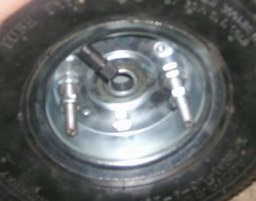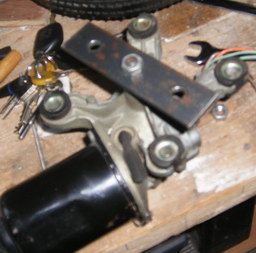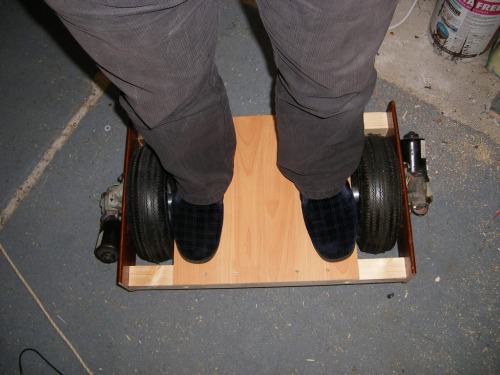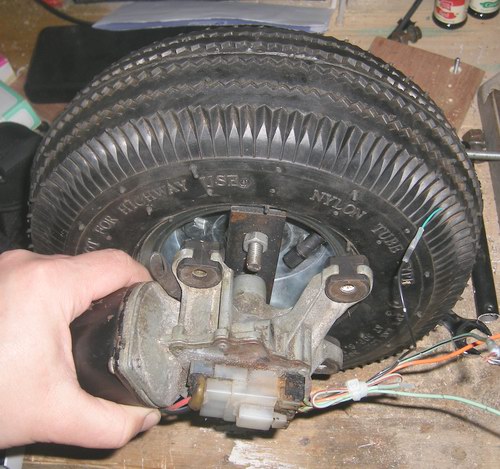2008-05-18
The deal is, this 'bot will (hopefully) follow me around. For me the challenge is to do something bigger than Lego scale.
So far, I have attached a car windscreen wiper motor to a pneumatic sack truck tyre. It's going to be BIG. The clue is in the name.
The wheel consists of two metal plates which are bolted together. I made a couple of extra long bolts and bolted a bit of mild steel to it. Bolted to the middle of the bit of steel is a windscreen wiper motor from a Nissan Micra.
Next weekend, I'm off down to the junk yard / scrap heap / scrappie (depending on your geographical location) to get another wiper motor. When I have two fitted to some sort of a chassis, I'll report back.
I envisage something powered by a couple of big FETs under PWM control with DPDT relays to reverse direction.
2008-05-24
Got my second wiper motor today. Found another scrap Nissan Micra down at my second favourite place (second only to the electronics store). Got the motor for $30. That's Not too bad. I could have haggled him down to $20, but I was in a hurry.

Remembered something else about these motors: They have a momentary switch internal to them which gets a hit every rotation. Cool! BUILT-IN SPEED SENSOR!!
2008-06-01
It would appear that my eldest son has decided that my new robot platform would make an excellent trailer for him to tow his younger brother behind his bike. As soon as I obtain custody of it, I'm ready to retrofit the motors.
I may or may not keep the plastic seat which has been bolted on top. At this stage, I'm thinking "radio-controlled pram" or maybe just automatic pram which follows me around. At last - a robot with a purpose!

2008-06-09
Built a new platform. It turns out the trailer is proving popular. New photo above. Hit a tiny problem. Not a showstopper. I mentioned a built-in SPCO switch in the wiper motor. I had hoped to use it as a rotation/speed counter. The problem is that the the motor "ground" wire is also the "normally open" contact of the switch. The plan was to connect the "normally closed" side of the switch to ground and run the switch common to the pic as an input (with pullup resistor enabled). Great when the N/C switch is closed, but for a brief second each rotation the switch changes over and the motor "ground" becomes switched into the PIC. Not a real problem for the PIC and if the motor is running "backward" (ie, ground is powered), the PIC will be able to increment a counter based onhe rising edge. HOWEVER, if the motor is running "forward" (ie ground is grounded) then the pic will detect no change.
Pisser.

BTW, this is 95kg (that's about 210lbs for our American friends) of ME
standing on the robot chassis. Early experiments show that it will easily plod along with a 25kg child sitting on it!!
I'm off to work on the circuit. I have a provisional one, but I want to separate the motor 12V from the TTL 5V onto two different PCBs.
2008-06-22
I thought about it a bit more and decided the drive board needed its own logic supply. (See next post.) The reasons will become clear as I explain further my modular robot electronics concept.
2008-07-07
New photo, new video. OKay, I wanted to prove that the controller board worked, so I programmed it to read the outputs from a radio control receiver. These are converted to 2's compliment byte values in the PIC and fed to the PWM controllers. The result is a pair of radio controlled windscreen washer motors with pneumatic wheels.
The platform currently has a "training" wheel. It seems likely this will be a feature for a while. I want to concentrate on the modular concept first, the person following, then the balancing act.
I'm very very happy with the motor control board and now I also have a good, usable routine should I ever build an I2C radio control receiver module.
Follow me carrying a 30kg child.
- Actuators / output devices: NIssan Micra windscreen wiper motors.
- Control method: Completely automagic.
- CPU: Microchip PIC.
- Operating system: BOA-OS
- Power source: 12V motorocycle battery.
- Programming language: PIC RISC assembler
- Sensors / input devices: Ultrasonic sensor with servo sweep. May add an accelerometer as a safety device.
- Target environment: outdoor, paved areas. Off-road would be nice.
This is a companion discussion topic for the original entry at https://community.robotshop.com/robots/show/big-chaser








 .
.